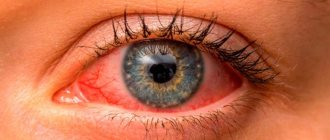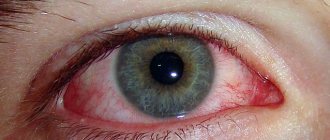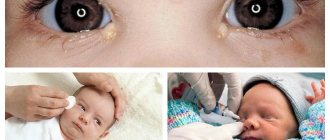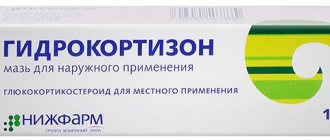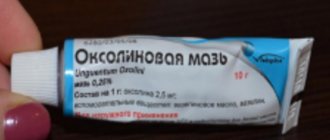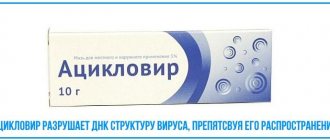An antibiotic for external use, used to treat eye infectious and inflammatory diseases. The main active ingredient of the drug is erythromycin . 1 g of the drug contains 10,000 units of erythromycin . Also contains: lanolin, petroleum jelly and sodium disulfite.
Indications for use:
- Conjunctivitis (including blepharoconjunctivitis).
- Bacterial blepharitis.
- Meibomite (barley).
- Keratitis.
- Ophthalmia of the newborn.
- Chlamydia eye infection.
- Trachoma.
Contraindications:
- Allergy to the components of the drug.
- Severe liver diseases.
It is worth using the medication during pregnancy and lactation and for treating infants only if the risk of side effects is lower than the expected benefit. Erythromycin passes into the placenta and breast milk.
Side effects : the occurrence of allergic reactions (redness, itching, burning, tissue swelling, increased tearing). With prolonged use of the drug, the development of a secondary infection is possible (as a result of microorganisms becoming accustomed to the active substance).
Produced in Russia. Available without a prescription.
Erythromycin ointment
An antibiotic for external use, used to treat eye infectious and inflammatory diseases.
The main active ingredient of the drug is erythromycin . 1 g of the drug contains 10,000 units of erythromycin . Also contains: lanolin, petroleum jelly and sodium disulfite.
Indications for use:
- Conjunctivitis (including blepharoconjunctivitis).
- Bacterial blepharitis.
- Meibomite (barley).
- Keratitis.
- Ophthalmia of the newborn.
- Chlamydia eye infection.
- Trachoma.
Contraindications:
- Allergy to the components of the drug.
- Severe liver diseases.
It is worth using the medication during pregnancy and lactation and for treating infants only if the risk of side effects is lower than the expected benefit. Erythromycin passes into the placenta and breast milk.
Side effects : the occurrence of allergic reactions (redness, itching, burning, tissue swelling, increased tearing). With prolonged use of the drug, the development of a secondary infection is possible (as a result of microorganisms becoming accustomed to the active substance).
Produced in Russia. Available without a prescription.
What to choose
For infectious eye lesions, both drugs can be used, as they are equally effective. But if long-term treatment is required, then you should choose a remedy with tetracycline, since it is less likely to cause resistance of pathogenic microorganisms to the antibiotic.
Tetracycline and erythromycin penetrate the placenta and breast milk, so they should be used very carefully during pregnancy and breastfeeding.
If medication is required to treat skin lesions, then only 3% tetracycline ointment is suitable. It should also be used to eliminate acne and rosacea, but for these diseases it is better to use other means aimed at combating acne specifically.
In pediatrics, both drugs are used; they are even prescribed to infants. For the treatment of ophthalmia in newborns, it is preferable to use erythromycin ointment.
It must be remembered that using medications without first consulting a doctor is fraught with complications and side effects. If therapy is required for a pregnant woman or a small child, then only a doctor should prescribe the medication.
Tetracycline ointment
A broad-spectrum antibiotic from the tetracycline group with a bacteriostatic effect . Used to treat infectious external diseases. Destroys the connection between tRNA and the ribosome in the bacterial cell, which leads to the suppression of protein synthesis.
The main active ingredient of the drug is tetracycline (tetracycline hydrochloride). Available in two forms - 1% (10,000 units) and 3% (30,000 units).
Indications for use:
| 1% ointment | 3% ointment |
| · Conjunctivitis. · Blepharitis. · Keratitis. Meibomite (barley). · Trachoma. · Lesions of the mucous membranes of the eyes due to rosacea. | · Furunculosis. · Purulent lesions of soft tissues and mucous membranes. · Infected eczema. · Acne (including rosacea). · Folliculitis. |
The medication should not be used if you are hypersensitive to the components of the drug or under the age of 11 years (for the 3% form).
During pregnancy and lactation, the drug can be used provided that the risk of side effects is lower than the expected benefit.
Side effects: allergic reactions (burning, itching, swelling and redness of tissues, increased tearing).
Produced in Russia. Available without a prescription.
Tetracycline
Tetracycline is a bacteriostatic antibiotic. It inhibits the synthesis of cellular proteins of microorganisms.
Gram-positive and gram-negative bacteria are sensitive to this drug, which is why it is also called a broad-spectrum antibiotic.
Tetracycline is prescribed for the following pathologies:
- Diseases of the respiratory system - bronchitis and pneumonia, pleurisy.
- Bacterial endocarditis.
- Dysentery and cholera.
- Typhoid and relapsing fever, tularemia.
- Gonorrhea.
- Pathologies of the urinary tract.
- Purulent skin lesions.
- Sore throat and scarlet fever.
However, today the use of tetracycline is limited due to its side effects. It can inhibit the hematopoietic system and increase the level of urea nitrogen in the blood.
When treated with this drug, children under 12 years of age experience irreversible discoloration of teeth in a gray, brown or yellow color. The same thing happens if you use it in the second trimester of pregnancy. That is why the medicine is prohibited in these categories of patients.
Currently, tetracycline tablets are used only as a reserve antibiotic - when other drugs are ineffective or when the sensitivity of microbes to this particular drug is confirmed.
However, tetracycline ointment has retained its practical importance. It is widely used in dermatology for the treatment of pustular skin diseases. The ointment is not absorbed and therefore is devoid of most of the side effects of tetracycline.
Similarities
Both medications are antibiotics and are intended to treat infectious eye diseases accompanied by the discharge of pus. They have a bacteriostatic effect - they suppress the proliferation of pathogenic microorganisms.
The products are produced in the form of an ointment and contain the same base - petroleum jelly, lanolin, sodium disulfite.
Erythromycin and tetracycline have the same indications for use - various types of conjunctivitis, blepharitis, keratitis, barley and trachoma. They can be used during pregnancy and breastfeeding, but only according to strict indications and provided that the expected benefit is higher than the risk of side effects in the fetus and child.
Both substances, erythromycin and tetracycline hydrochloride, form salts with calcium and iron ions, so it is not recommended to use medications simultaneously with dairy products (as they contain calcium), preparations containing iron, calcium, aluminum and magnesium salts.
The side effects of the products are also the same - they can cause burning and itching of the skin, swelling and hyperemia of the tissues.
Both drugs are produced in Russia and are sold without a prescription.
Causes of inflammation and redness of the eyes
Which eye ointment to choose for inflammation and redness depends on the nature of the disease. Redness and spider veins on the whites appear during various infections and allergies. Inflammation can be caused by viruses, fungi, bacteria, and negative environmental influences. It is almost impossible to independently determine the nature of the origin of the infection. Only an experienced doctor will be able to correctly diagnose and prescribe appropriate treatment.
The cause of the inflammatory process in the eye area can also be pathogenic microorganisms that live on the scalp and eyelids. To avoid such infection, it is necessary to have personal hygiene products (towels, glasses for sleeping), and also not to use other people's cosmetics (mascara, brushes for applying eye shadow). Allergic eye damage is often accompanied by a runny nose and swelling of the nasal mucosa. Bacterial pathologies often occur due to eye contact with dirty hands. Children are most susceptible to them. Viral diseases can even be transmitted through the air.
Differences
Despite the strong similarity, erythromycin and tetracycline ointments have some differences:
- The main difference between the products lies in the main active ingredient. Erythromycin ointment contains erythromycin , and tetracycline ointment contains tetracycline .
- Tetracycline ointment is available in two forms - 1% and 3%. The three percent form is used to treat infectious lesions of the skin and mucous membranes.
- Erythromycin can be used at any age, including children. Three percent tetracycline ointment is contraindicated in patients under 11 years of age.
- A drug containing erythromycin cannot be used for severe liver pathologies. It should also be used with extreme caution in case of kidney pathologies.
Erythromycin
Erythromycin is the first antibiotic from the macrolide group. It also has a bacteriostatic effect, but in high concentrations it can destroy bacteria.
This drug affects only gram-positive microbes; it does not have a wide spectrum of action.
However, intracellular parasites - chlamydia and mycoplasma - are sensitive to erythromycin, which makes it possible to use it for the treatment of atypical pneumonia. The medicine is also used when bacteria are resistant to beta-lactam antibiotics.
The main indications for prescribing erythromycin are:
- Diseases of the ENT organs.
- Atypical pneumonia and Legionnaires' disease.
- Diphtheria.
- Gonorrhea and syphilis.
- Erythrasma.
- Skin lesions.
Erythromycin can negatively affect the blood system, hearing, liver and kidneys. This limits its use.
Today, new, more effective and safe drugs from the macrolide group – clarithromycin and azithromycin – are widely used.
However, erythromycin ointment has proven itself well as a local remedy. It is widely used in ophthalmology.
The main similarity between tetracycline and erythromycin is that they belong to reserve antibiotics. They are prescribed when other remedies do not work or for certain diseases.
It is impossible to definitively answer which of these medications is better. Each of them is effective if prescribed according to indications.
antibiotics as active ingredients are used . They fight infectious agents. The most effective drugs are erythromycin and tetracycline ointments, and many patients wonder - which of these drugs is better and more effective?
Zovirax or Acyclovir?
There are two most popular ointments for eye treatment that have an antiviral effect - Acyclovir and Zovirax. They are absolute analogues. The active ingredient in them is acyclovir in the amount of 3 grams for every 100 grams of ointment. The following medications are used for viral lesions of the organs of vision: keratitis, conjunctivitis, herpes. The use of ointments is contraindicated only in case of hypersensitivity. As prescribed by the doctor, it is permissible to apply the product even during pregnancy.
The medicine is placed in a thin strip of no more than one centimeter into the lower eyelid 5 times a day. After recovery, it is important to continue using the drug for another three days. This will prevent relapse of the disease, which often occurs when the drug is stopped early.
“Vitapos” – eye moisturizing
The drug "Vitapos" is an eye ointment that is used to protect the cornea. This product contains retinol, paraffin, petroleum jelly and lanolin. These components are mixed with natural human tears and create an imperceptible film. The drug protects the eyes from drying out and irritation. Used when there is a negative influence of external factors (dry air, cold, working at a computer, dusty production, visual stress) the Vitapos product. Eye ointment is not applied to the visual organ only in case of increased sensitivity and while wearing lenses.
The drug is applied in a thin strip to the lower eyelid. Frequency of application – up to three times a day. It is known that the medication can slightly reduce visual acuity. Therefore, you should not use it while driving or performing important work. It is preferable to apply the product before bedtime.
